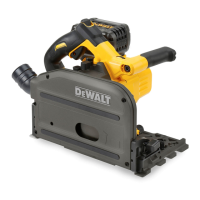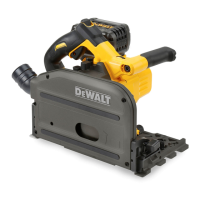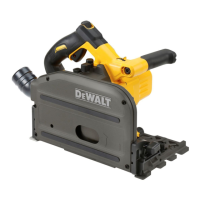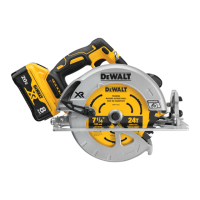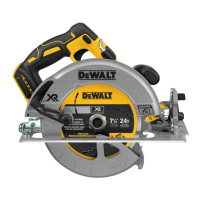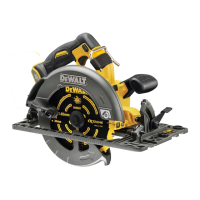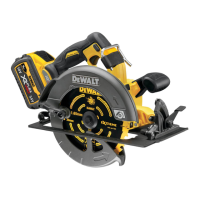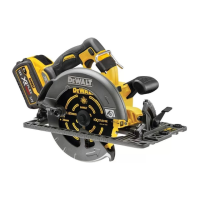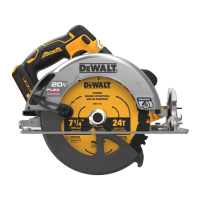39
ENGLISH
• The blade position indicator
29
shows the blade position
for full plunge.
• For optimum results, clamp the workpiece bottom up.
Cutting
1. Place the machine with the front part of the saw shoe
4
on
the workpiece.
2. Push the plunge trigger
1
forward, then press the on/off
switch
2
to turn the saw on.
3. Press the saw down to set cutting depth and push it forward
in the cutting direction.
Plunge Cuts
WARNING: To avoid kickbacks, the following instructions
MUST be observed when plunge cutting:
• Place the machine onto the guide rail and release the
anti-kickback knob
18
by turning it anti-clockwise.
• Turn the machine on and slowly press the saw down
onto the set cutting depth and push forward in the
cutting direction. The cutting indicators
27
display
the absolute front and the absolute rear cutting points
of the saw blade (dia. 165 mm) at maximum cutting
depth and using the guide rail.
• If kickback happened during the plunge cut, turn the
anti-kickback knob
18
anti-clockwise to release it
from the rail.
• When you have finished the plunge cut, turn the anti-
kickback knob
18
clockwise into the lock position.
Guide Rail System (Fig. A, F)
The guide rails
28
, which are available in different lengths,
allow for precise, clean cuts and simultaneously protect the
workpiece surface against damage.
In conjunction with additional accessories, exact angled cuts,
mitre cuts and fitting work can be completed with the guide
rail system.
Securing the workpiece with clamps ensures a secure hold and
safe working.
The guide clearance of the plunge saw must be very small for
best cutting results and can be set with the two rail adjustment
knobs
5
.
1. Release the screw inside the rail adjustment knobs
5
to
adjust the clearance.
2. Adjust the knob until saw locks on rail.
3. Rotate knob back until saw slides easily.
4. Hold the rail adjustment knob in position and lock the screw
again.
NOTE: ALWAYS readjust the system for use with other rails.
Anti-Splinter Guard (Fig. G, H)
The guide rail
28
is equipped with an anti-splinter guard
30
,
which has to be trimmed before the first use.
The anti-splinter guard
30
is situated on each edge of the
guide rail (
28
, Fig. G). The purpose of this anti-splinter guard is
to provide the user with a visible blade cut line while reducing
the chipping that occurs along the workpiece cut edge
duringcutting.
IMPORTANT: ALWAYS read and follow the Guide Rail System
instructions before cutting the splinterguard!
1. Set the speed of the plunge saw to level 7.
2. Place the guide rail
28
on a scrap piece of wood. Use a
clamp to ensure that the guide rail is securely attached to
the workpiece. This will ensure accuracy.
3. Set the plunge saw on 5 mm cut depth.
4. Place the saw on the rear end of the guide rail.
5. Turn the saw on, press it down to the set cutting depth and
cut the anti-splinter guard
30
along the full length in one
continuous operation. The edge of the anti-splinter guard
now corresponds exactly to the cutting edge of the blade.
To trim the anti-splinter guard on the other side of the guide
rail, remove the saw from the rail and rotate the rail 180°. Repeat
steps 1 through 4.
NOTE: If desired, the splinter guard can be bevelled to 45°, then
repeat steps 1 through 4. This allows one side of the rail for
cutting parallel cuts and the other side of the rail is tuned in for
45° bevel cuts (Fig. H).
NOTE: If the anti-splinter guard is trimmed for parallel cutting
on both sides, then when the unit is bevelled, the blade will not
run true to the edge of the anti-splinter guard. This is because
the pivot point of the unit bevel is not stationary and the blade
moves out when the unit is bevelled.
WARNING: To reduce the risk of injury, ALWAYS secure
the guide rail with a clamp.
Speed Adjustment (Fig. A)
The speed can be regulated between 2500 and 4200 rpm using
the speed wheel
19
. This enables you to optimise the cutting
speed to suit the material. Refer to the following chart for type
of material and speed range.
Type of Material to be Cut Speed Range
Solid wood (hard, soft) 3–7
Chipboards 4–7
Laminated wood, blockboards, veneered and coated boards 2–7
Paper and carton 1–3
Door Cutting (Fig. I)
1. Place the plunge saw with the outer guard
23
on a clean,
flat floor.
2. Press the shoe
4
with the front side on the door against the
adjusted depth stop.
Dust Extraction (Fig. A)
WARNING: Risk of dust inhalation. To reduce the risk of
personal injury, ALWAYS wear an approved dust mask.
Your tool is fitted with a dust extraction outlet
17
.
The Dust Extraction Adaptor allows you to connect the tool to
an external dust extractor, either using the AirLock™ system
(DWV9000-XJ), or a standard 35mm dust extractor fitment.
